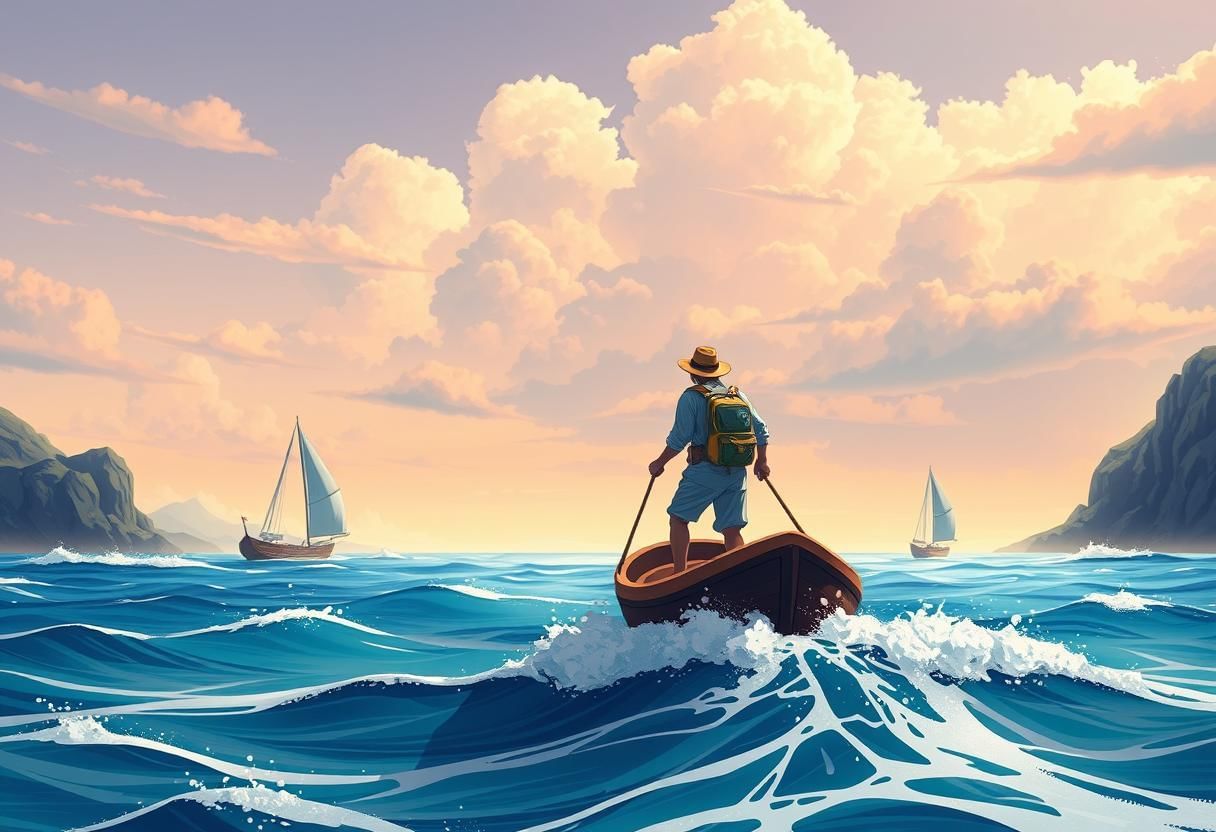Adventure Chapter Notes | Year 7 English IGCSE (Cambridge) - Class 7 PDF Download
| Table of contents |

|
| The start of an Adventure |

|
| Quest! |

|
| Train Trouble |

|
| A Hard Journey |

|
| Danger |

|
The start of an Adventure
Beware Low-Flying Girls
 Winter Adventure
Winter AdventureExtract 1
In Katherine Rundell’s "Beware Low-Flying Girls", Odile’s adventure begins on a snowy, windswept mountaintop where she discovers her extraordinary ability to fly. The cold bites, snow thick enough to conceal a cat, as Odile dons her father’s oversized coat, its once-rich brown faded to the hue of an old shoe, smelling faintly of horses and woodsmoke.
The sleeves, rolled up, hang heavily at her wrists. The fierce wind, a constant companion at the mountain’s peak, sends birds tumbling backward, shedding feathers like confetti, and occasionally blows seagulls into the house, startling Odile as she reads by the fire. Her grandfather, a lifelong mountaintop dweller, gently returns the birds outside, advising politeness, for “they know more than they let on.” The stone house, carved into the rock, burns a fire year-round, as her grandfather insists it stay as hot as a human heart.
Venturing out, Odile’s coat catches the wind like a sail, billowing as she runs down the path, hair whipping into her eyes. Suddenly, the wind lifts her, gravity unraveling for a fleeting second. She screams, crashing back to the snow, winded and gasping. Doubting whether she truly flew or merely tripped, she rubs snow into her eyes to ensure she’s awake, pins her hair with a frost-free twig, and dons gloves. Stretching the coat’s corners, she runs again, kicking up snow, and this time, undeniably, Odile flies, her breath misting the air as she soars.
Quest!
Extract 2
Learning her father once flew with the same coat and that her grandfather is gravely ill, Odile embarks on a quest in "Beware Low-Flying Girls" to find a healing plant on the mountain’s far side. Kissing her grandfather’s unusually cold cheek, she pulls on her boots and coat and sets out, his warning about the mysterious Kraiks—talking birds—echoing in her mind.
She walks the mountain paths, clapping her hands to warm them, then scrambles along treacherous edges where the ground drops into a blur below. Choosing not to fly, wary of fickle winds and gravity’s pull, she climbs cautiously. A foul stench—layered with smells like unbrushed teeth, week-old fish, and burnt fur—alerts her to danger. Whispering “Kraiks,” she scans the misty mountainside, seeing only branches stretching like arms. A thin, quiet voice calls out, “Where are you going, little girl?” Odile, jaw set, ignores it and presses sideways, her resolve unshaken despite the ominous presence, as she pursues the plant that could save her grandfather.
Train Trouble
 Vibrant Chaos
Vibrant ChaosAround India in 80 Trains
In Monisha Rajesh’s autobiographical "Around India in 80 Trains", the chaotic start of a journey unfolds at Chennai Egmore station, where a cacophony greets the narrator and her friend Passepartout before the station comes into view. Guided by Subbu, they rush through an obstacle course of wooden carts, dawdling men, hand-holding children, hobbling dogs, hessian sacks, nose-pickers, water-sellers, booksellers, and red-shirted porters.
Subbu, unruffled, reaches platform B2, while the sweat-soaked narrator and Passepartout, panting, trail behind. Engines hiss, announcements blare in rapid Tamil, and the stench of dried fish invades the air as Passepartout snaps photos. Boarding the Anantapuri Express to Nagercoil, they find Subbu has secured their seats and stowed their bags.
Their fellow passengers, amused, watch as they unpack water, notebooks, pens, toilet paper, flannels, and flip-flops, having already settled with chained bags and hidden shoes. At 7:20 p.m., the train jerks forward, and Subbu bows, slipping away as a saluting silhouette through the tinted window. The journey begins, a whirlwind of stress and motion, capturing the frenetic energy of Indian train travel.
A Hard Journey
 Oceanic Adventure
Oceanic AdventureHard is the Journey
In Li Po’s 8th-century Chinese poem "Hard is the Journey", the poet evokes the trials of a wanderer’s path. Amid opulent gold vessels and jade dishes brimming with costly meats, the speaker finds no satisfaction, laying down chopsticks and abandoning the banquet. Instead, he drops a hook into a brooklet, yearning for simplicity, and imagines sailing sunward in a boat.
Yet, confusion overtakes him as he draws his sword, staring wildly, lost in a maze of turnings. The journey’s hardships intensify—ice blocks the Yellow River, and snow cloaks the T’ai-hang mountains, barring his way. Hope emerges with a breeze breaking waves, signaling fair weather. Seizing the moment, he sets a cloud as his sail, crossing blue oceans, the poem’s vivid imagery weaving a tapestry of struggle, disorientation, and fleeting triumph in the face of nature’s formidable obstacles.
Danger
 Mystical waters
Mystical watersSilverfin
In Charlie Higson’s "Silverfin", young spy James undertakes a perilous mission to infiltrate a castle hiding a deadly secret. His only route is a precarious tree branch overhanging a loch teeming with eels. Struggling through twigs and limbs, James finds a barely suitable branch, the last strong enough to hold him. Lying flat, gripping it with his legs, he inches out over the black waters, imagining the eels’ slimy mouths waiting in the mud below. The thought that a fall might knock him unconscious, sparing him their bite, offers grim consolation.
Feeling utterly alone, knowing his friend Kelly won’t rescue him and no one else knows his whereabouts, James battles loneliness. Forcing his gaze to the castle wall, he crawls as the branch bends sharply downward, swaying alarmingly. Six feet, then five, then four from the wall, he stops at three feet, realizing the branch is too short and thin. Past the point of no return, a fall to the ground below would be worse than the water. Panic mounts as a creak, then a crack, signals the branch splitting, its shudder threatening to plunge him into the loch’s dark depths, heightening the suspense of his desperate gamble.
|
9 docs|9 tests
|
FAQs on Adventure Chapter Notes - Year 7 English IGCSE (Cambridge) - Class 7
| 1. What is the main theme of "The Start of an Adventure"? |  |
| 2. How does "Train Trouble" contribute to the suspense in the story? |  |
| 3. What types of dangers are encountered in "A Hard Journey"? |  |
| 4. How is suspense created in the narrative? |  |
| 5. What lessons can be learned from the adventure depicted in the article? |  |















